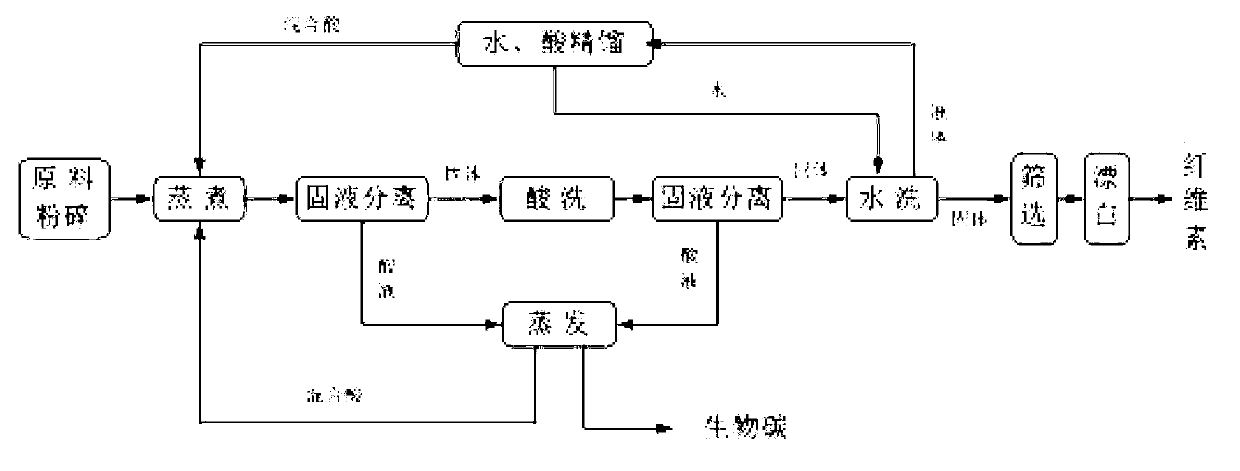Technologies for extracting cellulose from biomass raw material and preparing biochar
A biomass raw material and cellulose technology, applied in the field of cellulose extraction, can solve the problems that lignin and hemicellulose cannot be effectively utilized, and achieve the effects of shortening cooking time, reducing damage and high purity
- Summary
- Abstract
- Description
- Claims
- Application Information
AI Technical Summary
Problems solved by technology
Method used
Image
Examples
Embodiment 1
[0048] In this embodiment, the reeds are first crushed to a particle size of 2-10 cm.
[0049] The present embodiment extracts the technology of cellulose from described reed, comprises the steps:
[0050] (1) After the reeds are pulverized and pretreated, use the organic acid liquid whose total acid concentration is 70wt% formic acid and acetic acid to cook the treated reeds. The mass ratio of acetic acid and formic acid in the organic acid liquid of the present embodiment is 1: 1, and before adding the reed raw material, add the hydrogen peroxide (H 2 o 2 ) as a catalyst, control the reaction temperature at 125°C, react for 60min, and have a solid-liquid mass ratio of 1:5, and carry out the first solid-liquid separation of the obtained reaction solution;
[0051] (2) The solid that solid-liquid separation obtains for the first time is added the organic acid liquid that total acid concentration is 70wt% formic acid and acetic acid to carry out acid washing, wherein the orga...
Embodiment 2
[0062] In this embodiment, firstly, the rice straw is crushed to a particle size of 2-10 cm.
[0063] The present embodiment extracts the technology of cellulose from described rice straw, comprises the steps:
[0064] (1) After the rice straw is pulverized and pretreated, use the organic acid liquid whose total acid concentration is 90wt% formic acid and acetic acid to cook the treated rice straw. The mass ratio of acetic acid and formic acid in the organic acid liquid of the present embodiment is 1: 8, and before adding the straw raw material, add hydrogen peroxide (H 2 o 2 ) as a catalyst, control the reaction temperature at 145° C., react for 20 minutes, and have a solid-liquid mass ratio of 1:8, and carry out the first solid-liquid separation of the obtained reaction solution;
[0065] (2) the solid that solid-liquid separation obtains for the first time is added the organic acid liquid that total acid concentration is 90wt% formic acid and acetic acid to carry out acid...
Embodiment 3
[0076] In the present embodiment, firstly, the bamboo slices are crushed into flakes with a length of 2-10 cm and a thickness of 2 mm.
[0077] The present embodiment extracts the technology of cellulose from described bamboo chip, comprises the steps:
[0078] (1) After the bamboo chips are pulverized and pretreated, use the organic acid solution whose total acid concentration is 95wt% formic acid and acetic acid to cook the processed one, the mass ratio of acetic acid and formic acid in the organic acid solution of the present embodiment is 1: 6, and before adding the bamboo chip raw material, add hydrogen peroxide (H 2 o 2 ) as a catalyst, control the reaction temperature at 90°C, react for 40min, and have a solid-liquid mass ratio of 1:6, and carry out the first solid-liquid separation of the obtained reaction solution;
[0079] (2) the solid that solid-liquid separation obtains for the first time is added the organic acid liquid that total acid concentration is 95wt% fo...
PUM
| Property | Measurement | Unit |
|---|---|---|
| particle diameter | aaaaa | aaaaa |
| length | aaaaa | aaaaa |
| heating value | aaaaa | aaaaa |
Abstract
Description
Claims
Application Information
 Login to View More
Login to View More - R&D
- Intellectual Property
- Life Sciences
- Materials
- Tech Scout
- Unparalleled Data Quality
- Higher Quality Content
- 60% Fewer Hallucinations
Browse by: Latest US Patents, China's latest patents, Technical Efficacy Thesaurus, Application Domain, Technology Topic, Popular Technical Reports.
© 2025 PatSnap. All rights reserved.Legal|Privacy policy|Modern Slavery Act Transparency Statement|Sitemap|About US| Contact US: help@patsnap.com

